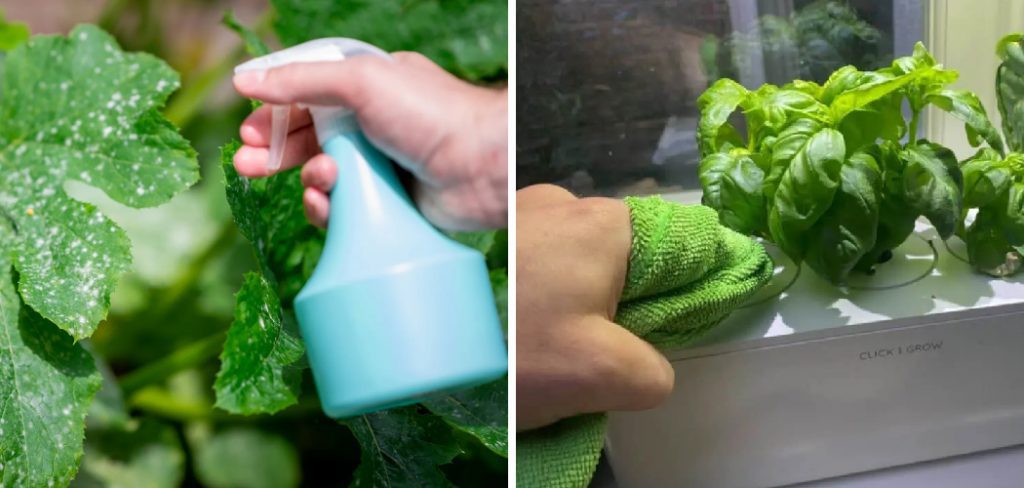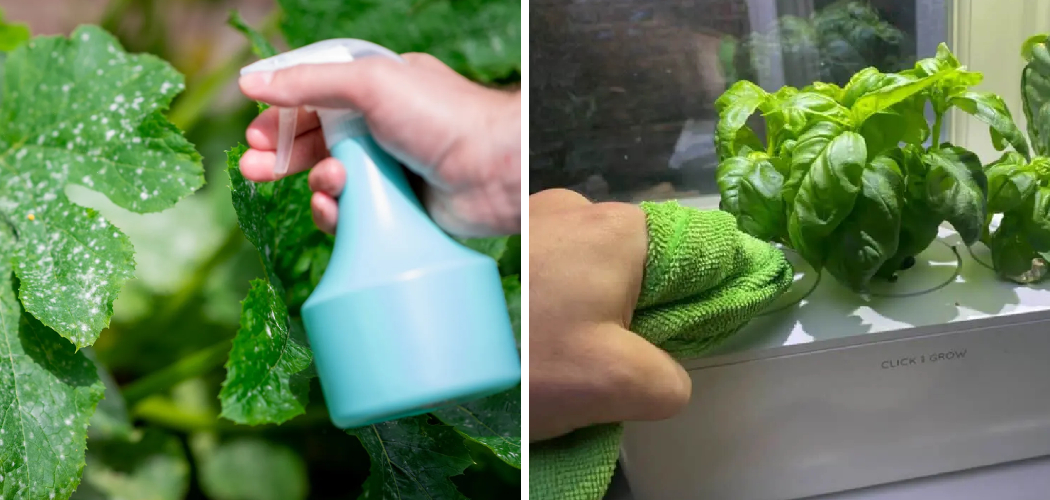To prevent mold in hydroponics, maintain proper ventilation and control humidity levels. In hydroponics, mold prevention is crucial to ensure healthy plant growth and prevent damage caused by mold growth.

High humidity can create a favorable environment for mold spores to thrive and multiply. To prevent mold, ensure adequate air circulation by using fans or ventilation systems and regularly monitor and control humidity levels using dehumidifiers or air conditioning. Additionally, maintaining a clean and sterile environment, using quality water sources, and regularly inspecting plants for signs of mold can also help prevent its growth.
By taking these preventive measures, you can minimize the risk of mold infestation and promote a healthier hydroponic system.
Identifying The Factors That Contribute To Mold Growth In Hydroponics
Mold growth in hydroponics can be prevented by addressing certain contributing factors. Improper ventilation and high humidity levels should be avoided as they create a favorable environment for mold. It is crucial to ensure proper air circulation and maintain humidity at an optimal level.
Additionally, poor water quality can lead to mold formation, so it is important to use filtered water and regularly clean the system. Furthermore, contaminated nutrient solutions should be identified and discarded to prevent mold infestation. Regular monitoring and maintenance of the hydroponic system will help in preventing mold growth and ensuring the overall health of the plants.
Taking these preventive measures will promote a successful and mold-free hydroponic gardening experience.
Implementing Effective Prevention Strategies
Implementing effective prevention strategies is essential to prevent mold in hydroponics. Proper ventilation and air circulation play a crucial role in maintaining a healthy environment. Monitoring and controlling humidity levels is equally important as excessive moisture promotes mold growth. Cleanliness should not be overlooked; regular maintenance and cleaning of system components are necessary.
Utilizing appropriate filtration systems can help remove potential mold spores and contaminants from the air and water. Additionally, it is crucial to regularly sanitize and disinfect the hydroponic system to prevent the buildup of mold and bacteria. By following these guidelines, you can effectively prevent mold and ensure the success of your hydroponic setup.
How to Prevent Mold in Hydroponics : Step by Step Guide
Selecting Plant Varieties That Are Less Susceptible To Mold Growth
Select plant varieties that are less susceptible to mold growth. Research mold-resistant plant species to prevent mold in hydroponics. Consider environmental conditions for plant growth to avoid mold infestation. Choose plants that have a natural defense against mold, such as varieties with thick leaves or disease-resistant traits.
Conduct thorough research to identify species that are known for their resistance to mold. Pay close attention to the temperature, humidity, and ventilation in your hydroponic system. Create an environment that discourages mold growth by maintaining proper air circulation and controlling moisture levels.
Regularly inspect your plants for signs of mold, such as fuzzy patches or discoloration, and take immediate action to prevent its spread. By taking these preventive measures, you can ensure a healthy and mold-free hydroponic garden.
Properly Maintaining Nutrient Solutions To Avoid Mold Contamination
Proper maintenance of nutrient solutions is crucial in preventing mold contamination in hydroponics. One key aspect is balancing nutrient ratios to ensure optimal plant health. By adjusting ph levels, you can further create an environment inhospitable for mold growth. Regularly monitoring and maintaining the quality of the nutrient solution is essential to prevent any potential mold issues.
Neglecting these preventive measures can lead to mold proliferation, compromising the success of your hydroponic system. Take proactive steps to keep mold at bay and ensure a healthy growing environment for your plants. With diligent care and attention, you can enjoy thriving hydroponic crops free from the harmful effects of mold.
Understanding The Impact Of Lighting On Mold Growth
Understanding the impact of lighting is crucial when it comes to preventing mold growth in hydroponics. Choosing the right type and intensity of lighting is important to minimize mold proliferation. By managing light cycles effectively, you can significantly reduce the risk of mold in your hydroponic system.
Ensure the lighting is suitable for the specific needs of your plants and avoid overexposure or inadequate illumination. Implementing a well-balanced lighting schedule will create an unfavorable environment for mold to thrive. Regularly monitor the humidity levels and adjust the lighting accordingly to maintain optimal conditions.
By proactively addressing the impact of lighting on mold growth, you can prevent mold-related issues and promote healthy plant growth in your hydroponics setup.
Dealing With Mold And Fungi In Hydroponic Systems
One way to prevent mold in hydroponics is to use organic fungicides and biological agents. These natural remedies can help control the growth of mold and fungi. Implementing cultural control methods such as maintaining proper ventilation and airflow can also be effective.
Another strategy is to treat affected plants promptly and isolate them from the rest of the system to prevent the spread of mold. It is important to regularly inspect and maintain the hydroponic system to identify any potential mold issues early on.
By taking these preventative measures, you can ensure a healthy and mold-free environment for your hydroponic plants. Safeguarding your hydroponics system from mold is crucial for successful cultivation and optimal plant growth.
Establishing A Routine Maintenance Schedule
Establishing a routine maintenance schedule is crucial in preventing mold in hydroponics. Cleaning and disinfecting the system components regularly is a vital step. Regular inspections should be conducted to identify any signs of mold or contamination. Taking proactive measures such as maintaining proper air circulation and humidity levels can prevent mold growth.
Furthermore, ensuring that the nutrient solution is properly balanced and regularly replaced is essential. Additionally, it is important to sterilize any new equipment before introducing it into the hydroponic system. By following these guidelines and maintaining a disciplined approach to maintenance, you can effectively prevent mold in your hydroponics setup.
Frequently Asked Questions Of How To Prevent Mold In Hydroponics
How Do I Keep Mold Out Of My Hydroponic System?
To prevent mold in your hydroponic system, follow these steps: 1. Maintain proper ventilation and airflow in your growing area to reduce humidity levels. 2. Regularly monitor and manage the water temperature in your system. Aim for temperatures between 65-75°f. 3.
Use sterilized equipment and clean your system regularly to prevent any potential mold growth. 4. Consider using beneficial bacteria or microbial products to help control mold and maintain a healthy balance in your hydroponic system.
What Causes Mold In Hydroponics?
Mold in hydroponics is mainly caused by excessive moisture levels. High humidity in the growing environment creates a favorable condition for mold development. Insufficient airflow and poor ventilation trap moisture, promoting mold growth. Lack of proper sanitization also contributes to mold in hydroponics.
When equipment, growing media, or nutrient solutions are contaminated, molds can easily thrive. Contaminated water sources, such as contaminated tap water or unfiltered water, can introduce mold spores to the hydroponic system. Moreover, using organic materials like compost or poorly sterilized substrates can also supply molds with a suitable environment.
To prevent mold in hydroponics, it is crucial to maintain proper airflow and ventilation, control humidity levels, regularly sanitize equipment and growing media, use clean and filtered water, and avoid the use of organic or poorly sterilized materials.
Do Hydroponic Plants Grow Mold?
Yes, hydroponic plants can grow mold if proper precautions are not taken.
What Is The White Fuzz On My Hydroponic Sponge?
The white fuzz on your hydroponic sponge is likely mold or mildew growth caused by excess moisture. Mold thrives in damp environments, such as sponges. To address the issue, reduce moisture levels by allowing the sponge to dry out between watering cycles.
If possible, provide better airflow around the sponge. Additionally, inspect the quality of your water source. Poor water quality can contribute to mold growth. Consider using filtered water or a water treatment system. Lastly, if the mold growth becomes severe, you may need to replace the sponge entirely.
Regularly monitoring and maintaining a clean, dry hydroponic system will help prevent the recurrence of mold or mildew.
Conclusion
To efficiently prevent mold growth in hydroponics systems, it is crucial to establish a comprehensive preventive routine. Regularly monitoring and adjusting environmental conditions, such as temperature and humidity, will contribute significantly to mold management. Maintaining proper ventilation and air circulation can also help in keeping mold at bay.
Implementing a strict cleaning and sanitization regimen will aid in the prevention of mold growth and the spread of any existing mold. Additionally, using a hydrogen peroxide solution to disinfect equipment and surfaces can be an effective strategy. Finally, incorporating natural mold-fighting agents like neem oil or cinnamon can provide an extra layer of protection.
By following these preventive measures consistently, hydroponic growers can minimize the risk of mold infestation and maintain healthy, thriving plants in their systems. Remember, prevention is key when it comes to mold control in hydroponics.

